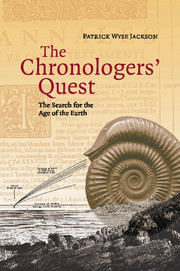Book contents
- Frontmatter
- Contents
- List of illustrations
- List of tables
- Preface
- Acknowledgements
- 1 The ancients: early chronologies
- 2 Biblical calculations
- 3 Models of Aristotelian infinity and sacred theories of the Earth
- 4 Falling stones, salty oceans, and evaporating waters: early empirical measurements of the age of the Earth
- 5 Thinking in layers: early ideas in stratigraphy
- 6 An infinite and cyclical Earth and religious orthodoxy
- 7 The cooling Earth
- 8 Stratigraphical laws, uniformitarianism and the development of the geological column
- 9 ‘Formed stones’ and their subsequent role in biostratigraphy and evolutionary theory
- 10 The hour-glass of accumulated or denuded sediments
- 11 Thermodynamics and the cooling Earth revisited
- 12 Oceanic salination reconsidered
- 13 Radioactivity: invisible geochronometers
- 14 The Universal problem and Duck Soup
- Bibliography
- Index
11 - Thermodynamics and the cooling Earth revisited
Published online by Cambridge University Press: 02 December 2009
- Frontmatter
- Contents
- List of illustrations
- List of tables
- Preface
- Acknowledgements
- 1 The ancients: early chronologies
- 2 Biblical calculations
- 3 Models of Aristotelian infinity and sacred theories of the Earth
- 4 Falling stones, salty oceans, and evaporating waters: early empirical measurements of the age of the Earth
- 5 Thinking in layers: early ideas in stratigraphy
- 6 An infinite and cyclical Earth and religious orthodoxy
- 7 The cooling Earth
- 8 Stratigraphical laws, uniformitarianism and the development of the geological column
- 9 ‘Formed stones’ and their subsequent role in biostratigraphy and evolutionary theory
- 10 The hour-glass of accumulated or denuded sediments
- 11 Thermodynamics and the cooling Earth revisited
- 12 Oceanic salination reconsidered
- 13 Radioactivity: invisible geochronometers
- 14 The Universal problem and Duck Soup
- Bibliography
- Index
Summary
In the middle of the nineteenth century numerous oceanographic voyages traversed the world's oceans revealing details of submarine topography and hitherto unseen animals. At much the same time telegraphic communications were being developed and the network in Britain expanded rapidly in the 1830s as the railways were laid out. By 1850 Britain had telegraphic links with France and Ireland, but it was soon realised that theoretically it could be possible to link Europe with distant continents including North America and Africa. In 1858 the first transatlantic cable was laid between Europe and North America but a month later problems with the insulation led to signal failure. In 1865 a new attempt to lay a cable followed but the line was lost. Undaunted, the steamer the Great Eastern set out on 13 July 1866 and began to lay a working cable for 2,000 miles between Valentia Island off southwest Ireland to Heart's Content, Newfoundland. Unusual for the time, this ship was powered by both paddles and screw propellers. It completed its voyage and the link by 27 July and a message was sent from Canada to Edward, Lord Stanley, the Prime Minister. The following day Queen Victoria sent a message in the opposite direction to Andrew Johnson, the President of the United States, from Osborne House and expressed her hope that the cable might ‘serve as an additional bond of union between the United States and England’.
- Type
- Chapter
- Information
- The Chronologers' QuestThe Search for the Age of the Earth, pp. 197 - 209Publisher: Cambridge University PressPrint publication year: 2006



